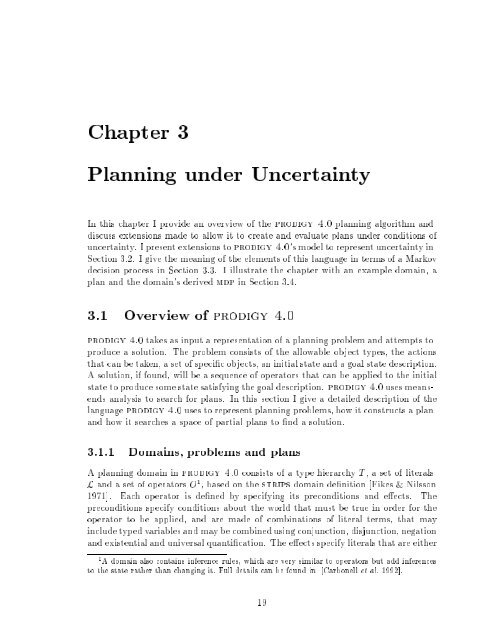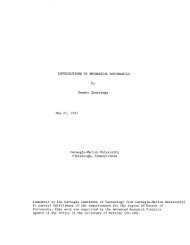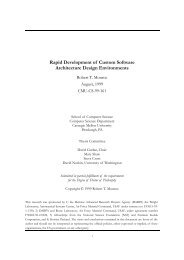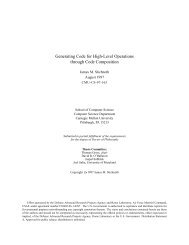Planning under Uncertainty in Dynamic Domains - Carnegie Mellon ...
Planning under Uncertainty in Dynamic Domains - Carnegie Mellon ...
Planning under Uncertainty in Dynamic Domains - Carnegie Mellon ...
Create successful ePaper yourself
Turn your PDF publications into a flip-book with our unique Google optimized e-Paper software.
Chapter 3<strong>Plann<strong>in</strong>g</strong> <strong>under</strong> <strong>Uncerta<strong>in</strong>ty</strong>In this chapter I provide an overview of the prodigy 4.0 plann<strong>in</strong>g algorithm anddiscuss extensions made to allow it to create and evaluate plans <strong>under</strong> conditions ofuncerta<strong>in</strong>ty. I present extensions to prodigy 4.0's model to represent uncerta<strong>in</strong>ty<strong>in</strong>Section 3.2. I give the mean<strong>in</strong>g of the elements of this language <strong>in</strong> terms of a Markovdecision process <strong>in</strong> Section 3.3. I illustrate the chapter with an example doma<strong>in</strong>, aplan and the doma<strong>in</strong>'s derived mdp <strong>in</strong> Section 3.4.3.1 Overview of prodigy 4.0prodigy 4.0 takes as <strong>in</strong>put a representation of a plann<strong>in</strong>g problem and attempts toproduce a solution. The problem consists of the allowable object types, the actionsthat can be taken, a set of specic objects, an <strong>in</strong>itial state and a goal state description.A solution, if found, will be a sequence of operators that can be applied to the <strong>in</strong>itialstate to produce some state satisfy<strong>in</strong>g the goal description. prodigy 4.0 uses meansendsanalysis to search for plans. In this section I give a detailed description of thelanguage prodigy 4.0 uses to represent plann<strong>in</strong>g problems, how it constructs a planand how it searches a space of partial plans to nd a solution.3.1.1 Doma<strong>in</strong>s, problems and plansA plann<strong>in</strong>g doma<strong>in</strong> <strong>in</strong> prodigy 4.0 consists of a type hierarchy T , a set of literalsL and a set of operators O 1 , based on the strips doma<strong>in</strong> denition [Fikes & Nilsson1971]. Each operator is dened by specify<strong>in</strong>g its preconditions and eects. Thepreconditions specify conditions about the world that must be true <strong>in</strong> order for theoperator to be applied, and are made of comb<strong>in</strong>ations of literal terms, that may<strong>in</strong>clude typed variables and may be comb<strong>in</strong>ed us<strong>in</strong>g conjunction, disjunction, negationand existential and universal quantication. The eects specify literals that are either1 A doma<strong>in</strong> also conta<strong>in</strong>s <strong>in</strong>ference rules, which are very similar to operators but add <strong>in</strong>ferencesto the state rather than chang<strong>in</strong>g it. Full details can be found <strong>in</strong> [Carbonell et al. 1992].19







